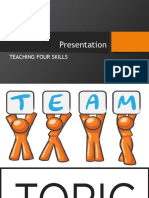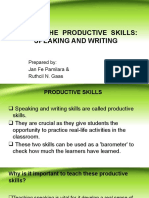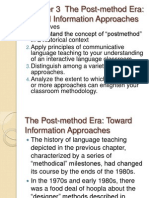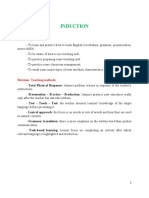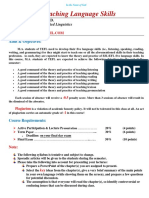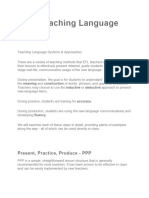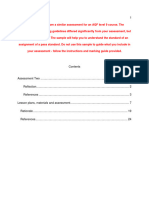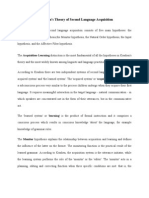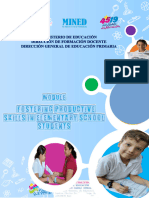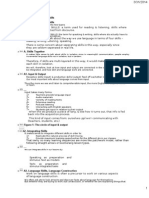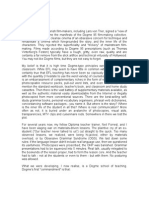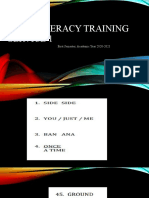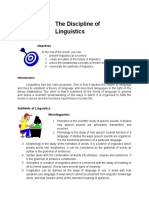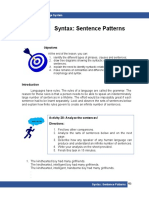0 ratings0% found this document useful (0 votes)
143 views34 pagesMethods of Teaching 2nd Language
Uploaded by
Allene Salili HoncadaCopyright
© © All Rights Reserved
We take content rights seriously. If you suspect this is your content, claim it here.
Available Formats
Download as PDF or read online on Scribd
0 ratings0% found this document useful (0 votes)
143 views34 pagesMethods of Teaching 2nd Language
Uploaded by
Allene Salili HoncadaCopyright
© © All Rights Reserved
We take content rights seriously. If you suspect this is your content, claim it here.
Available Formats
Download as PDF or read online on Scribd
You are on page 1/ 34
INTRODUCTION TO LANGUAGE EDUCATION;
The Nigerian Perspective
Copyright © 2019
Edited by: Esther N. Oluikpe
ISBN:978-978-979-39b-4
ALL RIGHTS RESERVED.
No part of this publication may be stored in a retrieval system, 1
or reproduced in any form or by any means, including photo. Tansmi
photograph, magnetic, or other record, or otherwise without the ps
agreement and written permission of the copyright owner, =
ted,
Many of the product names and logos referred to herein are trademars
registered trademarks of their respective owners. or
Published by:
SR“KKLE
Saree)
SPAKK & SPAKKLE LTD.
69 Obiagu Road,
By Afia Nine Bus Stop,
Ogui New Layout, Enugu,
Enugu State, Nigeria.
spakkledesign@gmail.com
+234 (0)8037417131
Printed in Nigeria
oe eae
CHAPTER 9
a
APPROACHES AND METHODS
IN SECOND LANGUAGE TEACHING
Ngozi U. Emelogu
ABSTRACT
This chapter defined approaches, methods, and techniques. It
operationalized approaches as the theoretical underpinning of methods.
Consequently, the chapter established the major theoretical orientations
which inform the teaching methods discussed in this chapter. Methods
were mapped against their theoretical orientations and described in
terms of features, techniques, merits and demerits, Based on empirical
support, suggestions are made on the methods best suited to various
language skills. The chapter concluded by sensitizing readers to current
thinking on pedagogy in the 21st century which is that approaches and
methods are inadequate to meet the pedagogical goals of education
which focuses on the transmission of knowledge driven by advances in
ICT to make learner embrace a better life. Consequently, there is a
movement away from approaches and methods to embrace teaching
strategies as best suited to meet the pedagogical demands of education
in the 21st century.
Keywords: Approaches in language teaching, methods in language
teaching, language pedagogy.
9.1 INTRODUCTION
This is the first in a series of chapters in this section of this book
which is devoted to pedagogical knowledge required of all language
education students. The core of language education is pedagogy which
is defined in this book as the art of teaching. Every language education
student is expected to be grounded in the art of teaching or else his
competence as a language teacher will be in doubt. Approaches and
methods have been fundamental in language teaching. However, a
paradigm shift, as pointed out in 1.4.5, from approaches and methods
205
ao ESTES EERE RUNTIME SR ge ACE h Rm
201 PART TWO: PEDAGOGICAL KNOWLeDge
6
1994) has been advocated. Thi.
as a post-method era. In Spite
hes and methods are essentiay
quently, it is discussed jn
to macro-strategies (Kumaravidivelu (
means that the 21st Century is regarded
of this advocated paradigm shift, approac
historical facts in language pedagogy. Conse’
this chapter as a historical artifact. 5 ‘
From a historical perspective, formal teaching of languages is
: ‘ nd techniques. These terms
hinged on certain approaches, methods at intouelvigws
are generally confused and need to be clarified. n oui > Approach
t in pedagogy, it means the focus of
is contextually used. In one context in p' eee ach
attention. For instance, we speak about teacher-cen! red approach when
attention is directed on the teacher as the custodian of knowledge and
the transmitter of knowledge to the learner. We speak about learner.
centred approach when attention is directed on the leaner in the
teaching process. In methodology, we have the cognitive-code
approach when attention is directed on rule-learning; the aura-oral
approach when the focus in on hearing-speaking in the teaching of
sounds. In another context, approach may be regarded as the theoretical
under-pinning of a method. It is in this context that Bell (1981) defines
it as "the theory of Applied Linguistics which seeks to explain the
phenomenon of language-learning in terms which will assist the learner
to achieve his goal" (p.75). In a similar vein, Prednasky and Prednasky
(n.d.) defines approach as the theoretical positions and belief about the
nature of language, the nature of language learning and the applicability
of both to pedagogical settings. For the purpose of this chapter, we
operationalize approach as the theory that underlies a method. In this
context, approach and theory are synonymous. That approach is often
confused with method is observed in the case of communicative
language teaching (CLT) which many regard as method. According to
Brown (2007), "CLT is an approach not a method because it is a
broadly based theoretical Position about the nature of language and
language teaching and learning focusing on communicative acts in
Context prompted by Hymes communicative competence" (p.266).
A method is the practical application of the approaches. Simply
Put, it is the way of teaching Something which use classroom activities |
to help learners learn. On the other han
Ip learners | d, a technique is a variety of
&xercises inclusive of teacher’s roles ai
ind students’ roles which are
——
APPROACHES AND METHODS IN SECOND LANGUAGE TEACHING 207
geared towards achieving lesson objectives. It must be pointed out that \|
in post-method era of the 21st Century, techniques, as We used to know i
it, has been renamed teaching strategies in the form of group work, H
demonstration, question and answer, experimentation, etc as discussed |
in chapter 16. Teaching strategies referred to as macro-strategies are
the substitutes of approaches and method in the 21st Century pedagogy.
Mora (2018) posits that there are four theoretical orientations
guiding the modern second language teaching methods. These
theoretical orientations are the approaches which underlie the various
teaching methods advanced for language teaching. They are:
e Structural/linguistic orientation |
« Cognitive orientation
e Affective/interpersonal orientation
¢ Functional/communicative orientation
In our view, these four theoretical orientations cannot adequately
account for the eleven teaching methods we have chosen to examine in
terms of their theoretical framework. These are:
¢ audio-lingual method | |
¢ grammar-translation method
¢ direct method
© cognitive-code learning method
total physical response
the silent method
suggestopedia |
immersion | |
the natural method |
community language learning
functional/notional method |
To adequately account for the theoretical base of each of the above
teaching methods, we have chosen to use the following theoretical
orientations:
* behaviorist orientation
* innatist orientation
* cognitivist orientation
© communicative language teaching (CLT) orientation
eoeoereee
ae
208 PART TWO: PEDAGOGICAL KNOWLEDGE
To ease our discussion, we provide below orientation/method mapping:
Behaviorist | Innatist orientation | Cognitivist orientation CLT orientation
orientation :
Audio-lingual | Total physical Grammar-transiation | Functional
method response method | method notional method
Suggestopedia Cognitive-code
Immersion learning method
The natural Direct method
method The silent way
Community language
language
Each orientation/method mapping is discussed in turn
9.2 BEHAVIOURIST ORIENTATION
The proponents of this theoretical orientation believe that
language is structured into constituents. Consequently, to learn a new
language is to learn the structures of the language. These structural
constituents are to be taught sequentially. Language is ‘learnt by
imitation, mimicry, constant practice and at the end new language
habits are formed which becomes as fixed as the mother tongue’ (Bell,
1981, p.24). Motivation was not considered as an important factor in
success or failure of language learning rather language learning was
achieved by building up of habits on the basis of stimulus-response
chains (Bell, 1981, p.97).The emphasis in this orientation is to teach
the grammatical structures, with the belief that the mastery of these
structures will amount to ability to use them in communication. This
led to teaching about the language. Emerging from this orientation is
audio-lingual method.
9.2.1. Audio-Lingual Method
The theory behind this method is that language learning is part
of habit formation where the correct responses attract rewards and
wrong responses call for punishment. Reinforcement is considered as
an important factor in language learning. Habits are constantly
reinforced when response to stimulus is positive and this goes on and
on till the response becomes part of the learner, The main objective of
a
APPROACHES AND METHODS IN SECOND LANGUAGE TEACHING 209
this method is to develop students’ oral skills. Based on this fact, the
teacher takes the center stage of students’ language learning by
modeling the target language correctly and the students repeat after the
teacher. The teacher continuously does this until the students have
grasped the structure then the teacher begins to introduce new words
for students to imitate the structure and produce the same pattern of
expression. At this point, the teacher expects a particular response from
the students and their inability to provide the desired response attracts
a negative Tesponse from the teacher. The idea behind this is that
reinforcing Correct behaviors will facilitate language learning. This
practice and repetition patterns are all done in the target language. The
students have little or no control over their own output. Rather they are
encouraged to tailor their expressions to the teacher’s grammatical
structures.
1. Features
e Dependency on practice, mimicry and memorization of language
structures.
« Grammar is taught inductively (giving examples first before stating
the rules).
¢ Great attention is given to native-like pronunciation.
¢ Skills are taught sequentially - listening, speaking, reading and
writing but greater emphasis is placed on listening and speaking
skills.
© Correct responses are reinforced.
Language laboratory, visual and audio aids are used.
Dialogue is used in presenting language items.
Students are not allowed to use mother tongue.
© Correct pronunciation and structure are emphasized.
2. Merits :
© Facilitates the learning of aural-oral skills.
© More student participation.
* Facilitates learning and vocal
visual aids.
bulary acquisition through the use of
2
210 PART TWO: PEDAGOGICAL KNOWLEDGE
© Suitable for large classes.
3. Demerits
¢ It is teacher-centered.
© It makes learning mechanical due to its pattern, practice, drilling
and memorization techniques. oe
© It doesn’t give adequate attention to communicative competence.
© Over-emphasis on error-free learning.
4. Techniques
Drills and pattern practice through repetition, substitution, addition,
combination and expansion of structures.
e Dialogue.
© Mimicry and memorization of teacher’s structures. (Lui & Shi,
2007)
93 INNATIST ORIENTATION
The application of the innatist orientation to second language
acquisition was engineered by Krashen (1977, 1981, 1982, 1992, and
1997). His contribution in this regard is popularly referred to as
Krashen's Input Hypothesis. The main position of the hypothesis is that
SLA is the same as L) acquisition because language acquisition device
(LAD) operates in the same way .in both adults and children.
Consequently, given sufficient and adequate comprehensible input,
LAD operates to acquire L2 step by step in a universal natural order of
acquisition. Failure to achieve native-like competence in L2 is caused
by affective factors such as motivation, fatigue, and other emotional
detractions (Oluikpe & Oluikpe, 2014). There are five hypotheses
which elaborated on the main provisions of input hypotheses. They are:
¢ The acquisition- learning hypothesis
The monitor hypothesis
Natural order hypothesis
Input hypothesis
Affective hypothesis
eo, SE
[APPROACHES AND METHODS IN SECOND LANGUAGE TEACHING 2
1. The acquisition-learning hypothesis
This hypothesis claims that the adult has two options available
to him or her in internalizing the second language-- acquisition and
learning. Acquisition is similar to Li acquisition process and focuses
on communication of messages and meaning. It is a spontaneous and
responsible for fluency. Consequently, it is superior to learning. On the
other hand, learning directs the attention of learners to forms and rules.
It is a conscious effort in which learners are generally conscious of their
efforts (Oluikpe & Oluikpe, 2014). Acquisition and learning are,
therefore, considered mutually exclusive for learning cannot turn into
acquisition.
2. Monitor hypothesis |
The focus of the monitor hypothesis is on learning, not |
acquisition. The monitor is a device for editing the learned system by
making corrections and alterations to what one had consciously
detected. In other words, it is the editing process of the learners’ output
to ensure the accuracy of the message in terms of forms and rules. For
this to occur, the following conditions must be satisfied on the part of
the editor:
¢ sufficient time
* focus on form
¢ knowledge of rules (Oluikpe& Oluikpe, 2014)
3. Natural order hypothesis
Motivated by the morpheme order studies of Dulay and Burt
(1974, 1976), Krashen hypothesized that learners acquire language
tules in a predictable or natural order. (Oluikpe & Oluikpe, 2014).
4, Input hypothesis :
For acquisition to occur, the acquirer must understand, through
learning or reading, language input that contain structures a bit beyond
his or her level of linguistic competence. For instance, if the acquirer is
at the level of i, the input he or she understands should contain i+1. This
Means that the language an acquirer or a learner is exposed to should
be beyond his or her level of linguistic competence. Further, the input
_
—,
212 P&RT TWO: PEDAGOGICAL KNOWLEDGE
should not be so far beyond his/her competence that he/she is
overwhelmed. Similarly, the input should not be so close to his/her
current level that he/she is not challenged at all. It means that he or she
should understand most of the content of the input except the (+1)
content. This difficult part of the content is processed through either
contextual clues or inferencing.
An important provision of this hypothesis is Krashen's
recommendation that speaking should not be taught directly or very
early in the language classroom. Speech will emerge once the learner
has built up enough comprehensible input (i + 1). (Oluikpe & Oluikpe,
2014).
Ss. The affective hypothesis
This hypothesis claims that acquisition and learning are
maximized in an environment-friendly atmosphere. That is to say that
the learner should be adequately disposed to learning. (Oluikpe &
Oluikpe, 2014).
The following teaching methods subscribe in one form or the other
to Krashen's input hypothesis:
¢ total physical response
¢ suggestopedia
e immersion
the natural method
Each is discussed in turn.
9.3.1 Total Physical Response (TPR)
In our view, this teaching method subscribes to Krashen's
acquisition-learning and input hypotheses. Acquisition-learning
hypothesis is implicated because learning is implicit (unconscious).
Input hypothesis plays a role because the simple commands given to
the learners form the input which the learners process to respond.
This method works by having the student respond to simple
commands such as ‘Stand up! Sit down! Close the door etc. The meth
stresses the importance of aural comprehension. The teacher gives the
students commands in the target language and the students act those
commands out using whole body responses. The proponents of this
——
APPROACHES AND METHODS IN SECOND LANGUAGE TEACHING 213
language teaching approach believe that understanding the spoken
language helps in developing the speaking skills.
. Features
The method emphasizes on aural skills. |
There is a combination of information and skills through the use of i|
kinetics sensory.
¢ Students assimilate information and respond rapidly.
¢ Students are not forced to speak but are allowed an individual
readiness period.
2. Merits
¢ Itis highly effective for young learners.
It improves listening skill. |
« Students participate actively.
3. Demerits |
¢ It is not all aspects of language learning that requires physical |
responses. Some aspects are abstract. |
© It focuses more on aural-oral skills. |
© Itcould be energy sapping for both the teacher and the students. |
4. Techniques |
© Use of commands to direct behaviour. |
¢ Action sequence. (Molina, Canado &Agullo, n.d.)
9.3.2 Suggestopedia
The theory underlying this method is that a language can be
acquired only when the learner is receptive and has no mental block.
This is the provision of Krashen's affective hypothesis. It is believed
that accelerated learning can take place when accompanied by de-
suggestion of psychological barriers and positive suggestions, hence
the name Suggestopedia - Suggestion and pedagogy (The network for
TEFL teachers, 2018). Learning takes place in a comfortable
environment that has dim light and comfortable chairs. Suggestopedia
ee
214 PART TWO: PEDAGOGICAL KNOWLEDGE
is a language method that emphasizes on the learner’s State of mind,
learner must be calm and relaxed; then there will bea Musical (soothin,
music) play in the background while teaching and learning is Soing on,
The method has different phases; the introduction, concert, elaboration
and production phases. In the introduction phase, the teacher Playfully
teaches the subject content instead of analyzing the content in a
directive manner. In the concert phase, the teacher can choose to use
the passive or active approach. In the active session, the teacher Teads
a text in a chanting manner with interval pauses while the students
listen. For instance, the teacher may choose an aspect of Creative
writing probably a poem. While reading the poem, the teacher will
intone his or her voice and as well add life to the literary devices used,
Occasionally, the students can read with the teacher. In the Passive
Session the reading is done calmly. The students are meant to visualize
the piece read by the teacher. It is believed that students’ imaginative
abilities are aroused as they sit in a comfortable environment with
background music, listening and watching the teacher display the
content of the material being read, A lot of visualization technique is
used at this phase. The elaboration phase is full of students’ activities.
The students sing and play games while the teacher acts as a consultant.
The production phase requires the students to spontaneously engage in
interaction in the target language without interruption or correction.
Though the teacher controls the lesson, it is a student-centered
approach. A teacher of suggestopedia must have adequate knowledge
and training on how to use the method in order to meet the objective of
the lesson and avoid negative impact on the students’ learning.
1. Features
¢ Itemphasizes on students’ creativity.
¢ The physical learning environment must be comfortable with
background music.
Students’ mental disposition is of great importance; the students
must be calm and relaxed.
Students are actively involved in dialogues, reading, singing, oF
playing games.
APPROACHES AND METHODS IN SECOND LANGUAGE TEACHING 215
2. Merits
It provides many valuable insights into the power of cognition and
creativity.
It employs techniques that make students to feel comfortable and
relaxed.
e Students participate actively.
3. Demerits
Due to the musical background, it is viewed as a placebo (i.e.
something that gives a mental relief) to psychiatric patients.
« Itis only suitable for adult learners.
© The learning environment of dim light, comfortable chairs and
music may be impossible in certain environments especially large
classes.
4. Techniques
¢ Cozy classroom environment.
¢ Visualization.
e Role play.
© Concert session ( Kriauciuniene, 2013)
9.3.3 Language Immersion
This is a method that involves the leaner to be taught in the
target language through the school period and also to learn other
subjects through the medium of the target language.
The underlying theory of this method ‘is Krashen's input
hypothesis. The learner is exposed to the target language as in first
language acquisition in which the acquirer is immersed in the mother
tongue. A student taught under this method is expected to listen to
materials in the target language, watch visuals in the target language,
communicate and respond in the target language. Just as the name
implies, the student is completely immersed in the target language.
There is early immersion where students begin to learn Lz from age 5-
6, middle immersion from age 9-10 and late immersion from age 11-
14. There are types of immersion. Total immersion is when students
i
PART TWO: PEDAGOGICAL KNOWLEDGe.
216
spend 100% of their class time in the Lz class. The second type is the
partial immersion where students spend 50% of their class time in the
Lz and the dual immersion where half of the students are bilingual and
they assist one another in learning the target language.
1, Features
© Allthe language skills are emphasized - speaking, listening, reading
and writing.
© Itinvolves immersion in both the target language and the culture of
the target language.
© The teacher is not the only instructor in an immersion program;
there is community of instructors such as neighbors, parents, and
business client's e.tc.
2. Merits
Ithelps in developing literacy skills.
e Fluency is acquired.
It helps in cognitive development as the learners begin to develop
metacognitive skills.
¢ For adults in foreign countries, it helps to improve their socio-
economic status.
Demerits
It is a difficult method for advanced students.
It encourages passive learning.
Students make disjointed expressions filled with grammatical
errors.
It is always difficult to get human and material resources that are
rich in language content and culture.
econ
. Techniques
Use of lots of audio-visual materials.
Use of body gestures.
Role plays.
Use of directions and signaling. (Fortune, 2019)
ec ooen
217
“apPROACHES AND METHODS IN SECOND LANGUAGE TEACHING
9.3.4 The Natural Approach
This method stresses that language learning takes place when
students are exposed to the language. The acquisition of Li is similar
with the acquisition of L2 in the sense that the learner acquires the target
language unconsciously through comprehensible input by the teacher.
Thus, this method, like the /anguage immersion method, is informed by
Krashen's input hypothesis. The learner is allowed to use mother tongue
alongside the target language but is mainly taught in the target
language. There is no teaching of grammar rules or structures rather the
teacher exposes the learner in the target language through various
exercises and the learner grapples with the language unconsciously.
1. Features
e Ly is acquired unconsciously and informally just like Li
« Atthe early stage, students are not corrected during oral production
as the teacher focuses on meaning than form.
¢ There is a silent phase, waiting for spoken production to emerge on
its own accord.
2. Merits
The use of both target and native language facilitate language
acquisition.
¢ It improves aural and oral skill.
. Demerits
The silent phase can hardly be determined.
It can make the classroom to be difficult to manage.
Only listening and speaking skills are emphasized
ecco ow
. Techniques
Dialogue.
Group work.
Role plays.
Games. (Molina, Canado&Agullo, n.d.)
cocoon
a
218 PART TWO: PEDAGOGICAL KNOWLEDG¢
For additional information, see William (1990), Avelino (2015),
Khan (2016); INTESOL (2018). ;
Although the various methods under the innatist orientation are
characterized by various techniques, there is identical theoretical
underpinning. All of them emphasize unconscious learning (Krashen's
acquisition/learning hypothesis), and exposure to the target language
(Krashen's input hypothesis).
9.4. COGNITIVIST ORIENTATION
This orientation views language as rule-governed and learning
as a mental process rather than an issue of stimulus-response. The
human innate ability which is universal facilitates the learning of
language. Therefore, it promotes the learning of language through
deductive reasoning whereby the learner is exposed to language use,
discovers elements of language use and the teacher guides the learner
in this intellectual struggle of making sense of the structure which
he/she is being exposed. While the teacher plans, directs and predicts
the learner’s needs in the behaviorist orientation, the cognitive
psychologists believe that the teacher should act as a resource centre
and a judge for the learner as he picks his individual way through the
intellectual puzzle that is anew language (Bell, 1979). Lesson contents
are selected based on concepts and techniques that facilitate learning
about the language and through this approach the learner gains
competence that leads to performance. This orientation is also centered
on learning about the language.
The methods we consider to fall under this orientation are:
© grammar-translation method
direct method
cognitive-code learning method
the silent way
community language learning method
Each is discussed in turn.
[APPROACHES AND METHODS IN SECOND LANGUAGE TEACHING 219 |
9.4.1 Grammar-Translation Method
In this method, emphasis is placed on students learning the rules
of the language deductively and applying these rules by translating
sentences from the native language to the target language and vice
versa. It is believed that language is rule-governed; therefore, it is
appropriate to learn about the language through mastery of the
grammatical structures. Language is reduced to a grammatical system |
|
|
|
|
|
where sentence becomes the main unit of references and its
y morphological elements are organized according to a series of
prescriptive rules (Molina, Canado&Agullo, n.d.). Language rules are
stated first before examples are given and this leads to memorization or
rote learning of the rules. The main objective of this method is to
produce students who can apply the rules learnt in reading and writing
activities, thereby de-emphasizing speaking and listening skills.
Another objective of the method is to develop students’ general mental
discipline as language learning process demands mental discipline
1, Features
Learning mainly involves the mastery of grammatical rules and |
memorization of vocabularies.
Rules of grammar are acquired from simple to complex. |
« A lot of exercises on reading and writing through translation. |
Translation of disconnected sentences from target language to the
mother tongue and vice versa.
, © The major classroom instructional material is the textbook. |
* Accuracy is emphasized.
Rote learning is encouraged.
Reading aloud in the target language.
2. Merits
¢ Ithelps in development of
© Itcan be economical in ce
applying them.
«It facilitates reading and writing skills.
students’ mental discipline.
tain situation to learn the rules before
—~uay
220 PART TWO: PEDAGOGICAL KNOWLEDGE
3. Demerits
© Neglects aural-oral skills.
* Over emphasis on accuracy.
¢ Lack of activities for developing communicative competence.
© Little or no attention is placed on pronunciation.
© Lack of active participation of students.
¢ Itis teacher-centered.
- Techniques
Translation of literary passages.
Reading and answering questions from comprehension passages.
Dictation.
Antonyms and synonyms.
Filling-in-the-blanks.
Memorization. j
Drills on sentence construction. (Molina, Canado & Agullo, n.d.)
eoceoe oo en
9.4.2. Direct Method
This method was born as a result of the inadequacies of
grammar-translation method. Direct method primarily focused on
teaching and learning in the target language without any form of
translation. There is no room for the use of mother tongue.
Students/leamers are taught grammar inductively. Examples are
presented and practiced first before the rules are given. The oral skill is i
greatly emphasized as students are taught to pronounce like the native |
speakers. The learning of spelling and writing are delayed until students
have gained competence in speech. Printed materials and text are kept
away from second language learners until they have gotten good grasp
of speech (Applied Linguistics, 2008). The main objective of this
method is to train students to think in the target language and acquire
the target language in a natural way just like the first language. The
teacher engages students in dialogue that helps them practice the target
language and bring the passive vocabularies to active mode. Though it |
is a teacher-centered approach, students participate actively by
a8
[APPROACHES AND METHODS IN SECOND LANGUAGE TEACHING 221
expressing their thoughts and feelings directly in the target language
without using their mother tongue.
Features
Teaching is centered on oral skills.
A lot of question-answer pattern is used.
Visual materials are used in the teaching of concepts and
vocabularies.
Grammar is taught inductively.
Literature texts are read for comprehension and pleasure and not
for grammar.
e Students engage in practice and repetition exercises.
e Emphasis is more on the target language.
© The mother tongue is never used and there is no translation.
2. Merits
Active participation of students.
Improves fluency of speech.
Bridges the gap between theory and practice.
Helps in making passive vocabulary to become active.
Full of activities that make learning to be interesting and exciting.
© Develops the four language skill but emphasizes more on listening
and speaking.
¢ Makes use of audio-visual aids that facilitates learning.
3. Demerits
© Not appropriate in lower-level classes.
© Less suitable for slow learners who are still struggling in the target
language.
© Requires skilled teachers that have good command of the target
language.
© Does not teach grammar systematically.
¢ Not appropriate for large classes.
© Does not improve reading and writing skills.
2 as ee
TE
222 PART TWO: PEDAGOGICAL KNOWLEDGE
4. Techniques
° Reading aloud.
* Question and answer exercises.
e Dialogue.
© Student self-correction. (Lui& Shi, 2007)
9.4.3 Cognitive-Code Learning Method
This method was born out of the dissatisfaction with the choral
nature of audio-lingual method. The proponents of this method claim
that language learning is rule formation and not habit formation. Hence,
a lot of emphasis is placed on grammar rules but differs from grammar-
translation method in the sense that the method provides more practice
in all the language skills. It is considered as a modern version of
grammar-translation method’ (Demirezery, 2014, p.306). Writing is
seen as important as speech in this method. Since Lz speakers cannot
speak exactly like the Li speakers, there is less emphasis on
pronunciation in this method. Learners are involved in variety of group
and individualized activities. There is a conscious effort by the teacher
to help learners acquire the phonological, grammatical and lexical
patterns of the second language.
1. Features
© Grammar rules are learnt deductively.
© There is explicit explanation of grammatical rules.
Teacher ensures that students/learners understand the linguistic
rules before practice through drills.
e Language is promoted as an active mental process than a process of
habit formation.
e There is emphasis on content than form.
2. Merits
¢ It develops the students cognitively because they are always
engaged in active information processing.
¢ There is more emphasis on guided discovery grammar rules.
—
“APPROACHES AND METHODS IN SECOND LANGUAGE TEACHING 223
e Errors are accepted as natural occurrences in the process of learning
asecond language.
Demerits
There is little or no student-teacher interaction.
There is little or no use of examples from authentic materials.
There is more emphasis on understanding language structure than
using the structure.
e Itis not suitable for large classes.
e Itis teacher-centered.
4. Techniques
« Use of discovery techniques.
¢ Use of previous knowledge as a platform to relate new materials or
concepts.
e Use of situational drills. (Gomath, 2011). I
|
9.4.4 The Silent Way Method
This is a discovery learning approach where the teacher is
largely silent, giving more space for students to explore and use the |
target language. Students are largely responsible for their own learning,
and are encouraged to express themselves. There is no use of mother
tongue in this method. The role of the teacher is to observe, give signals H
‘ or use body gestures to indicate correct or wrong responses such as. |
raising of fingers. The teacher only corrects the students’ errors when
necessary. The students describe objects shown by the teacher or
describe actions performed by the teacher. The method shares the same i
principle with cognitive-code learning which underlying principle is i
discovery learning. The students discover things on their own and can i
form their hypothesis based on their discoveries. For instance, a student
can notice the inflections at the end of verbs based on their tenses and
can come up with the hypothesis that some verbs that are in the past
have an inflection of ‘ed’ at the end.
7 —~y
PART TWO: PEDAGOGICAL KNOWLEDGE
1, Features
© Language is seen as a problem solving activity to be engaged in by
students and the teacher needs to stay out of the way in the process
as much as possible.
¢ The teacher plays the role of a facilitator.
© The method encourages personal production of students’ own kind
of expressions.
© The teacher uses finger to indicate wrong or correct answers.
¢ The teacher uses colored word charts for sounds and colored rods
for grammar and syntax.
«© The method encourages group work, peer correction and self-
correction.
2. Merits
° The exploratory technique of language learning makes the method
unique.
¢ Students play very active role.
¢ There are lots of visual materials at the students’ disposal.
3. Demerits
¢ It encourages teachers to assume a distance that prevents direct
guidance.
¢ The method is too focused on building language structure.
¢ The teacher’s silence prevents the students from learning active
models of correct usage.
¢ The silence nature is too far to the extreme.
© It will require the teacher to invest heavily on instructional
materials.
Techniques
Use of sound-color charts,
Teacher’s silence,
Peer correction.
Use of colored rods.
Self correction gestures by the teacher
Cr a es
eS
ApeROACHES AND METHODS IN SECOND LANGUAGE TEACHING
Structured observation (Kriauciuniene, 2013).
9.4.5 Community Language Learning Method
This method is based on the counseling approach in which the
teacher is seen as a counselor and the student is a client. Based on this
counselor/client relationship, attempts are made to remove fear and i
anxiety from the student. The student (client) and teacher (counselor),
build strong personal links so that there are no psychological |
inhibitions in learning. This method encourages interaction as a vital |
aspect of language learning and prioritizes students’ feelings and their
struggles in language learning. It also emphasizes that intellect and
ability are not separated from feelings hence the creation of an |
environment of mutual support, trust and understanding between |
student-client and teacher-counselor. There is no syllabus or textbooks
to follow in this method instead the students (clients) determine the |
content of the lesson. They speak in their mother tongue and the teacher
translates to the target language. This translation is further recorded and
this can serve as the students’ learning material. They listen to the
translations repeatedly and also record their own translations for the
teacher to listen and correct. This process can be done interchangeably
and repeatedly until students gain confidence in the use of the target
language.
1. Features
© Students determine the content of the lesson.
¢ Teachers are perceived as empathy agents hence they are referred
to as counselors.
© Students learn in a relaxed atmosphere without any fear or anxiety.
© The seating arrangement is informal; always in a circle form.
© There is use of both mother tongue and target language.
© Students are encouraged to express themselves in the target
language only when they feel ready and confident enough to do so.
n
~ Merits
The method addresses affective factors in learning.
226
w
eee on
PART TWO: PEDAGOGICAL KNOWLEDGE
The method combines language learning with principles of
counseling.
There is a high level of interaction |
thereby removing anxiety and constitul
of learners. ;
The student-centered nature of the method provides both extrinsic
and intrinsic motivation for the students. :
Tape recording and transcriptions are useful elements in language
learning.
between students and teachers
ting a supportive community
. Demerits
It is non-directive.
The method relies completely on inductive learning.
Over emphasis on affective factors at the expense of other
considerations.
It requires great expertise from the teacher in both the target
language and mother tongue.
It is not appropriate for large classes.
. Techniques
Tape recording of student/teacher conversation.
Transcription.
Reflective learning.
Small group tasks. (Molina, Canado&Agullo, n.d.)
The above teaching methods appear together, in spite of variations
in technique and focus, because their underlying orientation is the
learning of rules either inductively or deductively.
9.5
COMMUNICATIVE LANGUAGE TEACHING
ORIENTATION
In 9.1, we noted that communicative language teaching is not a
method (Bell, 198 1). Itis an approach. Consequently, we have regarded
CLT as an orientation which has fructified into many methods. We
shall not treat all the methods associated with CLT in this book. We
‘ppRORCHES AND METHODS IN SECOND LANGUAGE TEACHING 227
have chosen just one of the methods to serve as an example of the
methods in CLT.
It is believed that communication does not take place in a vacuum
put different situations call for different communication purposes. As a
result, language teaching should be centered on using language to meet
various communication needs. Contextual meaning is at the forefront
of this perspective. According to Bell (1981), this approach to language
learning seeks to provide the learner not only with the linguistic
knowledge which permits the learner to create and understand
grammatical sentences (linguistic competence) but also the social
knowledge and skill which permit the learner to produce and
comprehend socially appropriate _ utterances (communicative
competence). Learners are not limited to only mimicking the teacher’s
expressions but have the freedom to express themselves according to
the social settings. Errors at this level are seen as part of learning. The
emphasis is more on fluency than accuracy. The learning of the second \
language should take a natural approach where students will make great \
input than depending on imitating the teacher’s expressions. \
We have chosen the functional-notional method as a typical |
example of CLT orientation.
9.5.1 Functional-Notional Method |
This method is a total turn-around from linguistic or structural
aspect of language learning to the communicative aspect of language }
learning. Language learning is contextualized in this method. It is
believed that different situations bring about variations in the use of
language. Functional refers to functional curriculum or syllabus which
is organized around different functions of language such as exchange
of information, expressing personal feelings, giving commands,
making request etc. Notion refers to semantic knowledge or meaning
as it relates to the contexts or situations that call for language use.
According to Bell (1981), one word that describes this language
method is text or discourse. The communication needs of learners in a
discourse situation is paramount than the acquisition of grammatical
structures that are not based on any context. The teacher in this method,
‘focuses on analyzing, synthesizing and teaching dynamic discourse
int
———
228 PART TWO: PEDAGOGICAL KNOWLEDGE
rather than the decontextualized sentences of the structural approach’
(Bell, 1981, p.132). Brown (2007) points out that the basic teaching
techniques in this method includes eclectic blend of conversation
practice with classmates, interactive group work, role plays, grammar
and pronunciation focus exercise, information gap techniques, internet
activities and extra-class interaction practice.
Features
Language teaching is based on students’ needs.
Meaning takes greater emphasis than grammar.
Use of textbooks that are designed according to students’ needs.
More emphasis on students’ communicative competence.
2. Merits :
e It integrates concern for the social aspects of language and
individual roles in language interaction.
© It improves students’ communicative competence and linguistic
competence.
Students practice language in a context.
3. Demerits |
¢ Difficulty in determining which function should be dealt with
before the other.
¢ Difficulty in determining the suitability of the syllabus materials for
beginning learners.
¢ No provision for background knowledge before learners can get
into role plays.
|. Techniques
Interactive group work.
Role plays.
Information gap technique.( William, 1990)
econ
eS ee
"APPROACHES AND METHODS IN SECOND LANGUAGE TEACHING. 229 i
9.6 TEACHING METHODS |G OF
LANGUAGE SKILLS AND THE TEACHIN
: The variation in strengths and weaknesses of the language
teaching methods examined in this chapter is a clear indication that
some methods are more effective in certain language skills than others.
For the teaching of speaking and listening skills, teachers may adapt
their lesson to any of the following methods:
« audio lingual method
natural method,
direct method, |
total physical response method
the silent way.
The techniques used in these methods promote listening and
speaking skills. For example, when students listen, observe, mimic and
try to discover certain concepts on their own, they are actively engaged
in both habit formation and language processing. The teacher’s i
comprehensible input serves as a model for them. Also, the real life
objects and audio-visual materials used as teaching aids in these |
methods do actively engage and expose the students to language use. i
There are empirical support of the use of these language teaching
|
i
ij
methods in teaching listening and speaking skills. For instance, Abdul
and Hijrah (2013) and Semacio (2018) revealed an increase in students’
achievement scores in the listening and speaking skills through the use
of audio- lingual method. Kazuo and Koji (n.d.) also revealed that total
(TPR) method improved students listening and
speaking skills and vocabulary acquisition. Shi (2018) and Toghyani
and Mansour (2017) also corroborated the findings above that TPR has
greatly enhanced students learning efficiency.
For the teaching of reading and writing skills, the following
teaching methods have been found adequate:
¢ Community language learning method
© suggestopedia
These two metho
techniques and high I
language learning encoul
students can monitor their
physical response
ds could yield better results due to their unique
level of students’ participation. Community
rages reflective learning in the sense that
learning through the translations. Reflective
pant TWO: PEDAGOGICAL KNOWLepge
230
sy ills. Tugrul and
learning also improves reading and hte learning ee
(2013) quipped that translation is @ sete sion ofa second language o,
of ESL learners as it facilitates Soe sana (2015) showed that
a foreign language. The study in % learning met
students’ participation in community sare tal factor ieee
increased their motivation. Motivation 1S one learning generally. The
proficiency in reading and writing skills and in ic, together with the
comfortable environment, adorned ee et Iso. increases the
rs di i sstopedia mel ;
teacher’s displays in suggestop' reativity and spur them to
motivation level of the students, stir their © v ;
write. Grammar- translation method emphasizes accuracy. It is
effective in the teaching of grammar but can be very eect sien it
plays a supportive role to other language teaching methods that
emphasize fluency such as:
¢ Suggestopedia
© Cognitive-code learning method
These methods use variety of techniques to enhance students
learning of the four language skills. Students are exposed to elaborate
language use in varying contexts and situations without any inhibition
or limitations. The supportive role of grammar- translation method
enables the students to acquire both fluency and accuracy in the
language use. According to Chang (2011), fluency and accuracy are the
major targets for English language learning. Studies of Chang (2011),
Egbe (2015), and Tan (2016) revealed that communicative language
teaching approaches improve students’ proficiency in the four
language skills. Although some studies such as Ahmad and Rao (2013),
Okueso, Osikaomaiya, Osijo, Omotayo and Arowolo (2018) posit that,
for effective learning to take place and for a better result in the teaching
of the four language skills using the communicative language teaching
approaches, a classroom with audio-visual aids and a well-trained and
active teachers with good command of English must be put in place.
Language immersion is always most appropriate for students
learning English language as a foreign language. The total immersion
into the target language enables students of English as a foreign
language (EFL) to acquire both the language and the culture of the
language. The proficiency level required of the learners is almost same
en
APPROACHES AND METHODS IN SECOND LANGUAGE TEACHING ~
with native speakers. Nikula and Miettinen (2014) showed that
immersion learners’ sociolinguistics competence is closer to that of
native speakers in contexts where students have good opportunities for
out of school contacts with the immersion language. Finally, success in
language teaching depends on how flexible the teacher is in the use of
the methods. Various students’ needs call for different methods. An
effective language teacher should be able to apply an eclectic blend of
different methods in order to achieve the teaching and learning
objectives. A blend of the traditional structural methods with the
communicative approaches will make for an effective language
teaching. Just like Williams (1990) advised that, in adopting what is
new, we should not do away with the valuable clements of the old
methods. As Rivers (1972) succinctly puts it ‘The eclecticists try to
absorb the best techniques of all the well-known language teaching
methods into their classroom procedures, using them for the purpose
for which they are most appropriate’. Therefore, there is no one method
that is most appropriate but through flexibility in the application of the
methods, students’ communicative and linguistic needs can be met.
9.7 CONCLUSION
Advances in ICT has transformed the 21st century into a
knowledge-based economy (see chapter 16 for knowledge-based
economy). This transformation has consequences on education in the
21st century. The goal of education in this century is the transmission
of knowledge required to make us self-reliant citizen equipped to
engage in economically useful ventures. This goal of education also has
consequences on language pedagogy. Focus on approaches and
methods have been found to be inadequate to achieve the educational
objectives in the 21st century. Consequently, there is a paradigm shift
away from approaches and methods to embrace teaching strategies as
the most effective pedagogical means to realize the goal of education,
Based on this development, the discussion in this chapter on
approaches and methods serves as historical facts of language
pedagogy. It also serves to sensitize readers to current thinking in
language pedagogy.
LL
232 part TWO: PEDAGOGICAL KNOWLEDGE
9.8 REVIEW QUESTIONS |
1. List two language teaching methods from each of the theoretical
positions :
a. Explain the methods liste j
b. List the features, merits and demerits of the methods
2. Illustrate with four examples, the language teaching methods that
can be used in teaching listening and speaking skills
There is no best method. Justify this assertion.
4. What is the difference between direct method and the natural
approach? ‘ 4
5. Discuss the role of the following teaching methods in the teaching
of language skills:
suggestopedia
community language learning
natural method
audio-lingual method
total physical response method
functional-notional method
w
REFERENCES
Abdul, N., B. & Hijrah, H. (2013).7he use of audio- lingual method in
teaching listening comprehension at the second year students
of smkyapip Makassar sungguminasa, Retrieved from
https://www. researchgate.net
Ahmad, S. & Rao, C. (2013). Applying communicative approach in
teaching English as a foreign language: A case study of
Pakistan. Porta Linguarium Junio 20, 187 — 203. Retrieved
from https://www.ugr.es
Applied Linguistics (2008). First language acquisition. Retrieved from
www.kau.edu.sa/files/00087 I 8/subjects/chapter'%202.pdf.
Avelino, J. (2015). Communicative language teaching. Retrieved from
https://www.slideshare.net.
APPROACHES AND METHODS IN SECOND LANGUAGE TEACHING. 238)
Bell, R., T. (1981). An introduction to applied linguistics: Approaches
and methods in language teaching. London, UK: Batsford Ltd.
Brown, H., Dz. (2007). Principles of language learning and teaching.
White Plain, NY: Pearson Education.
Chang, S. (2011). A contrastive study of grammar-translation method
and communicative approach in teaching English grammar.
Retrieved from https://www.semanticscholar.org
Demirezery, M. (2014). Cognitive-code theory and foreign language
learning relations. International Online Journal of Education
and Teaching (IOJET), \(5), 309-315. Retrieved from
http://iojet.org.
Dulay, H. & Burt, M. (1974). You can't learn without goofing. In J.
Richards (Ed), Error analysis: Perspectives on second
language acquisition (pp.95-123). London, U.K: Longman.
Dulay, H. & Burt, M. (1976). Creative construction model in second
language and teaching. Language Learning, Special issue
no.4,65-79.
Egbe, C., I. (2015). Effects of integrative language teaching approach
on secondary school students’ achievement. Retrieved from
www.unn.edu.ng
Fortune, T., W. (2019). What research says about immersion.
Retrieved from https://carla.umn.edu
Frankfurt International School (n.d). Language — teaching
methodologies. Retrieved from http://www. fis.edu.
Freeman, D., L. (1990). Language teaching methods. Teacher's
handbook for the video series. Retrieved from www.pdf.net.
Gomath, K. (2011). Cognitive-code learning. Retrieved from
www.elihinkel.org.
INTESOL (2018). English teaching methods. Retrieved from
www.huntesl.com
ee
234 PART TWO: PEDAGOGICAL KNOWLEDGE
Kazoo, W. & Koji, K. (n.d.). Long -term retention of English through
TPR in a Japanese junior high school. Retrieved from
https://www. citeseerx.ist.psu.edu
Khan, M., A. (2016). Advantages and disadvantages of communicative
language teaching. Retrieved fromhttps:/Avww.online journal.
org.uk,
Krashen, S. (1977). The monitor model for adult second language
performance. In M. Burt & H. Dulay (Eds), View points on
English as a second language (pp. 115-160). New York, NY:
Regents Publishing Co.
Krashen, S. (1981). Second language acquisition and second language
learning. Oxford, U.K: Pergamon Press.
Krashen, S. (1982). Principles and practice in second language
acquisition. Oxford, UK: Pergamon Press.
Krashen, S. (1985). The input hypothesis. London, U.K: Longman.
Krashen, S. (1992). Under what condition if any should grammar
instruction take place? TESOL Quarterly, 26, 409-411.
Krashen, S. (1997). Foreign language education: The easy way. Culver
city, CA: Language Education Associates.
Kriauciuniene, R. (2013). Modern teaching methods and strategies |
part I. Retrieved from https://educationdocbox.com i
Kumaradivelu, B. (1994). The postmethod condition: Emerging
strategies for second/foreign teaching. TESOL Quarterly, 28,
27-48.
Liu, X. & Shi, J., F. (2007). An analysis of language teaching
approaches and methods-effectiveness and weakness. US-China
Education Revenue, 4(1), 69-71.
Major approaches of teaching English (n.d). Retrieved from
www.bhojvirtualuniversity.com
Molina, G., T., Canado, M., L., P. &Agullo, G., L. (n.d). Current
approaches and teaching methods; bilingual programmes.
APPROACHES AND METHODS IN SECOND LANGUAGE TEACHING 235
Retrieved from https://www4.ujaen.es/gluque/ Chapter4HAND
BOOKDEFINITIVO.pdf : ef ‘
Mora, J., K. (2018).Second and foreign language teaching methods.
aoe from https://www.moramodules.com/ALMMethods.
Nikula, T. & Miettinen, K., M. (2014). Language learning in
immersion and CLIL classrooms. Retrieved _ from
www.researchgate.net >
Nurhasanah, S. (2015). The use of community language learning
method to increase the students’ participation in classroom
conversation. Register, 8 (1), 81 — 98. Retrieved from
https://media.neliti.com
Okueso, S., A., Osikaomaiya, M., O., Osijo, Y., E., Omotayo, A., 0. &
O., A. (2018). Effective teaching of English language using
communication package: How prepared are the teachers in
Ogun state, Nigeria? European Journal of English Language
and Literature Studies, 6 (2), 30 - 40 |
Oluikpe, B. & Oluikpe, E. (2014). Principles of second language
development: Processes, theories, variables, and issues. |
Onitsha, Nigeria: Africana-First Publishers.
Prednasky, Z. & Prednasku, P. (n.d). English language teaching
methodology. Retrieved from http://www.englishraven.com/
methodology.
Revolvy, M. (2018). Audio-lingual method. Retrieved from
https://www.revolvy.com.
Rivers, W.. M. (1972).Teaching foreign language skills (Swed.).
Chicago, IL: The University Press
Semacio, M. (2018). English speaking proficiency of the grade 11
using audio- lingual method. Surigao City, Philippines: Surigao
State College of Technology Retrieved from www.acadmia.edu
Ce nn ee
236 PART TWO: PEDAGOGICAL KNOWLEDGE
Shi, T. (2018). A study of the TPR method in the teaching of English
to primary school students. Theory and Practice in Language
Studies, 8 (8), 1087 - 1093
Tan, Z. (2016). An empirical study on the effects of grammar-
translation method and task-based language teaching on
Chinese college _ students’ reading comprehension.
International Journal of Liberal Arts and Social Science, 4 (3),
100 - 109
The network for TEFL teachers (2018).Language teaching methods:
Suggestopedia. Retrieved from https://www.tefl.net.
Toghyani, K., A. & Mansour, K. (2017). Effects of total physical
response method on students’ achievement in English
vocabulary. International Journal of Evaluation and Research
in Education. Retrieved from https://eric.ed.gov
Tugrul, C., M. & Matt, T. (2013). The grammar-translation method
and the use of translation to facilitate learning in ESL classes.
Retrieved from https://www.researchgate.net
Vardanyan, A. (n.d). Community language learning: Pros and cons.
Retrieved from https://www.employment.education
Williams, D. (1990). English language teaching: An integrated
approach. Ibadan, Nigeria: Spectrum Books Limited.
You might also like
- Techniques and Principles in Language TeNo ratings yetTechniques and Principles in Language Te45 pages
- Cognitive Academic Language Learning Approach: CALLA's Basic PremisesNo ratings yetCognitive Academic Language Learning Approach: CALLA's Basic Premises2 pages
- Testing The Productive Skills: Speaking and Writing: Prepared By: Jan Fe Pamilara & Ruthcil N. GaasNo ratings yetTesting The Productive Skills: Speaking and Writing: Prepared By: Jan Fe Pamilara & Ruthcil N. Gaas25 pages
- Technology Integration and Teachers' Competency in The Development of 21st-Century Learning in EFL ClassroomNo ratings yetTechnology Integration and Teachers' Competency in The Development of 21st-Century Learning in EFL Classroom8 pages
- Modern Approaches in Language Teaching Summary of MethodsNo ratings yetModern Approaches in Language Teaching Summary of Methods8 pages
- Approaches and Methods in Language Teaching - Chapter 19No ratings yetApproaches and Methods in Language Teaching - Chapter 1915 pages
- TESOL Pre Interview Language Awareness Task 2016No ratings yetTESOL Pre Interview Language Awareness Task 20166 pages
- 962 Teaching Language Skills, ShahrekordNo ratings yet962 Teaching Language Skills, Shahrekord4 pages
- A Comparison Between Deductive and Inductive Appro100% (1)A Comparison Between Deductive and Inductive Appro13 pages
- The Direct Method: Best To All! Waleed AlsultaniNo ratings yetThe Direct Method: Best To All! Waleed Alsultani2 pages
- Summary of Principles in Language Teaching: Provided by Dr. Bill Flick, Director of ESL at Auburn100% (2)Summary of Principles in Language Teaching: Provided by Dr. Bill Flick, Director of ESL at Auburn2 pages
- Overview of Language Teaching MethodologyNo ratings yetOverview of Language Teaching Methodology19 pages
- Description of Krashen's Theory of Second Language AcquisitionNo ratings yetDescription of Krashen's Theory of Second Language Acquisition3 pages
- Grammar Teaching-Practice or Consciousness-Raising - Ellis - Sem Comentários...No ratings yetGrammar Teaching-Practice or Consciousness-Raising - Ellis - Sem Comentários...5 pages
- Fostering Productive Skills in Elementary School Student Parte 2No ratings yetFostering Productive Skills in Elementary School Student Parte 211 pages
- Imported Communicative Language TeachingNo ratings yetImported Communicative Language Teaching8 pages
- ELT Seminar: Principles of Teaching EnglishNo ratings yetELT Seminar: Principles of Teaching English7 pages
- The TESOL Encyclopedia of English Language Teaching - 2018 - Ali - Community Language LearningNo ratings yetThe TESOL Encyclopedia of English Language Teaching - 2018 - Ali - Community Language Learning5 pages
- Teaching Listening: Teaching English As A Foreign LanguageNo ratings yetTeaching Listening: Teaching English As A Foreign Language10 pages
- The Input Hypothesis: Wan Maisarah Nurul Atiqah Liyana Farah Ahmad TirmieziNo ratings yetThe Input Hypothesis: Wan Maisarah Nurul Atiqah Liyana Farah Ahmad Tirmiezi6 pages
- Handouts in Lesson 1 Language Teaching Methods and ApproachesNo ratings yetHandouts in Lesson 1 Language Teaching Methods and Approaches4 pages

